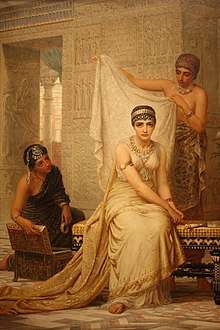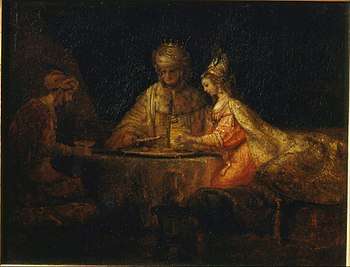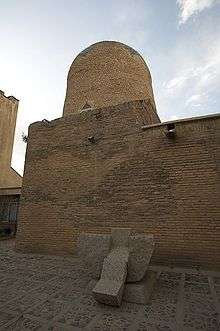Esther
| Esther | |
|---|---|
| Queen of Persia | |
 Queen Esther (1879) by Edwin Long | |
| Queen of Persia | |
| Reign | c. 479 – c. 465 BC |
| Coronation | c. 479 |
| Predecessor | Vashti |
| Born |
Hadassah c. 492 BC Achaemenid Empire |
| Burial | Hamadan, Iran |
| Spouse | King Xerxes I of Persia[1] |
| House | Persia |
| Father | Abihail (biological), Mordecai (adoptive) |
| Religion | Judaism |
Esther[lower-alpha 1] is described in the Book of Esther as a Jewish queen of the Persian king Ahasuerus. In the narrative, Ahasuerus seeks a new wife after his queen, Vashti, refuses to obey him, and Esther is chosen for her beauty. The king's chief advisor, Haman, is offended by Esther's cousin and guardian, Mordecai, and gets permission from the king to have all the Jews in the kingdom killed. Esther foils the plan, and wins permission from the king for the Jews to kill their enemies, and they do so.
Her story is the traditional basis for Purim, which is celebrated on the date given in the story for when Haman's order was to go into effect, which is the same day that Jews kill their enemies after the plan is reversed.
Etymology
It has been conjectured that the name Esther is derived from a reconstructed Median word astra meaning myrtle.[2] This would match her Hebrew name as recorded in the Bible, Hadassah, also meaning "myrtle".
The Targum[3] connects the name with the Persian word for "star", setareh (In Persian: ستاره), explaining that Esther was so named for being as beautiful as the Morning Star. In the Talmud (Tractate Yoma 29a), Esther is compared to the "morning star", and is considered the subject of Psalm 22, because its introduction is a "song for the morning star".
An alternative view is that Esther is derived from the theonym Ishtar. The Book of Daniel provides accounts of Jews in exile being assigned names relating to Babylonian gods and "Mordecai" is understood to mean servant of Marduk, a Babylonian god. "Esther" may have been a different Hebrew interpretation from the Proto-Semitic root "star/'morning/evening star'",[4] which descended with the /th/ into the Ugaritic Athtiratu[5] and Arabian Athtar.[6] The derivation must then have been secondary for the initial ayin to be confused with an aleph (both represented by vowels in Akkadian), and the second consonant descended as a /s/ (like in the Aramaic asthr "bright star"), rather than a /sh/ as in Hebrew and most commonly in Akkadian.
Wilson, who identified Ahasuerus with Xerxes I and Vashti with Amestris, suggested that both "Amestris" and "Esther" derived from Akkadian Ammi-Ishtar or Ummi-Ishtar.[7] Hoschander alternatively suggested Ishtar-udda-sha ("Ishtar is her light") as the origin with the possibility of -udda-sha being connected with the similarly sounding Hebrew name Hadassah. These names however remain unattested in sources, and come from the original Babylonian Empire from 2000 BCE, not the Chaldean Empire or Persian Empire of the Book of Esther.
In the Bible

In the narrative, King Ahasuerus is drunk at a festival and orders his queen, Vashti, to appear before him and his guests to display her beauty. When she refuses to come, he deposes her and seeks a new queen through a sort of beauty pageant. Esther, an orphan daughter of a Benjamite named Abihail and under the protection of her cousin Mordecai, who are members of the Jewish exile community in Persia, is chosen.
Later, Mordecai refuses to bow to Haman the Agagite, who was recently made Ahasuerus' highest advisor, and Haman requests and is given permission to order all the Jews in Persia to be killed. When Esther learns of this, Mordecai tells her to reveal to the king that she is Jewish and to ask him to repeal the order. Esther hesitates, saying that she could be put to death if she goes to the king without being summoned and the king does not want to see her; Mordecai urges her to try. She goes to the king, and the king welcomes her, and says he will give her anything she wants. Instead of asking directly about the order, she invites the king and Haman to a banquet the next day. During the banquet, the king again asked Esther if there is anything she wants, and this time she asks the king to spare her life and that of all of the Jews. The king asks who was threatening them, and she names Haman. Haman throws himself at her feet; the king thinks that Haman is attacking her and orders him to be put to death, and gives all Haman's possessions to Esther. Esther tells the king about Mordecai's role in her life, and the king makes Mordecai his highest advisor. Esther then asks the king to revoke the order, and king allows Esther and Mordecai to do so, however they wish. They send out an order in the king's name that Jews can assemble and defend themselves, and can kill anyone who threatens them, and their families, and take their goods. On the thirteenth day of Adar, the same day that Haman had set for them to be killed, the Jews do so in one city, killing 500 people but not taking plunder, and they kill around 75,000 the next day again not taking plunder, and then they feast.[8]
_-_Aert_de_GELDER_-_Google_Cultural_Institute.jpg)

Purim
The Jews established an annual feast, the feast of Purim, in memory of their deliverance. Haman set the date of Adar 13 to commence his campaign against the Jews. This determined the date of the festival of Purim.[9]
Interpretations
Dianne Tidball argues that while Vashti is a "feminist icon", Esther is a post-feminist icon.[10]
Abraham Kuyper notes some "disagreeable aspects" to her character: that she should not have agreed to take Vashti's place, that she refrained from saving her nation until her own life was threatened, and that she carries out bloodthirsty vengeance.[11]
The tale opens with Esther as beautiful and obedient, but also a relatively passive figure. During the course of the story, she evolves into someone who takes a decisive role in her own future and that of her people.[12] According to Sidnie White Crawford, "Esther's position in a male court mirrors that of the Jews in a Gentile world, with the threat of danger ever present below the seemingly calm surface." [13] Esther is related to Daniel in that both represent a "type" for Jews living in Diaspora, and hoping to live a successful life in an alien environment.
Esther as rhetorical model
According to Susan Zaeske, by virtue of the fact that Esther used only rhetoric to convince the king to save her people, the story of Esther is a "rhetoric of exile and empowerment that, for millennia, has notably shaped the discourse of marginalized peoples such as Jews, women, and African Americans", persuading those who have power over them.[14]
Persian culture

Given the great historical link between Persian and Jewish history, modern day Persian Jews are called "Esther's Children". A building venerated as being the Tomb of Esther and Mordechai is located in Hamadan, Iran,[15] although the village of Kfar Bar'am in northern Israel also claims to be the burial place of Queen Esther.[16]
Depictions of Esther
There are several paintings depicting Esther, including one by Millais.
Canonicity in Christianity
The status of Esther as a canonical book of the Bible has historically been under dispute. For example, in the first several centuries of Christianity, Esther does not appear in the lists of books produced by Melito, Athanasius, Cyril, Gregory of Nazianzus, and others. Additionally, no copies of Esther were found at Qumran in the contents of the Dead Sea Scrolls. Nevertheless, by the fourth century CE, the majority of Western churches accepted Esther as a part of their Bibles.[17]
Esther is also commemorated as a matriarch in the Calendar of Saints of the Lutheran Church–Missouri Synod on May 24. She is also recognized as a saint in the Eastern Orthodox and Coptic Orthodox Churches. "The Septuagint edition of Esther contains six parts (totaling 107 verses) not found in the Hebrew Bible. Although these interpretations originally may have been composed in Hebrew, they survive only in Greek texts. Because the Hebrew Bible’s version of Esther’s story contains neither prayers nor even a single reference to God, Greek redactors apparently felt compelled to give this secular tale a more explicitly religious orientation, alluding to “God” or the ‘Lord” fifty times."[18] The approximate dates for the Additions to Esther in the Apocrypha are: second or first century BCE. [19][20]
Notes
References
- ↑ Robert J. Littman (January 1975). "The Religious Policy of Xerxes and the Book of Esther". The Jewish Quarterly Review.
- ↑ Barton, John; John Muddiman (2001-09-06). "Esther". The Oxford Bible Commentary. Oxford University Press. ISBN 9780198755005.
- ↑ Targum to Esther 2:7
- ↑ Huehnergard, John (2008-04-10). "Appendix 1: Afro-Asiatic". In Woodard, Roger D. The Ancient Languages of Syria-Palestine and Arabia. Cambridge University Press. pp. 225–246. ISBN 9781139469340.
- ↑ Rahmouni, Aïcha; Ford, J. N. (2008). "Section 1, The Near and Middle East". Divine Epithets in the Ugaritic Alphabetic Texts. Brill. p. 86. ISBN 9004157697.
- ↑ Offord, Joseph (April 1915). "The Deity of the Crescent Venus in Ancient Western Asia". Journal of the Royal Asiatic Society of Great Britain and Ireland: 198. JSTOR 25189307.
- ↑ NeXtBible Study Dictionary, entry "Ahasbai" Archived 2008-12-22 at the Wayback Machine.
- ↑ Hirsch, Emil G.; Prince, John Dyneley; Schechter, Solomon (1936). "Esther". Jewish Encyclopedia. New York: Funk & Wagnalls Co.
- ↑ Crawford, Sidnie White. "Esther: Bible", Jewish Women's Archive
- ↑ Tidball, Dianne (2001). Esther, a True First Lady: A Post-Feminist Icon in a Secular World. Christian Focus Publications. ISBN 9781857926712.
- ↑ Kuyper, Abraham (2010-10-05). Women of the Old Testament. Zondervan. pp. 175–176. ISBN 9780310864875.
- ↑ Coogan, Michael David; Brettler, Marc Zvi; Newsom, Carol Ann and Perkins, Pheme. The New Oxford Annotated Bible, Oxford University Press, 2007 ISBN 9780195288803
- ↑ Crawford, Sidnie White. "Esther", Eerdmans Commentary on the Bible, (James D. G. Dunn, John William Rogerson, eds.), Wm. B. Eerdmans Publishing, 2003 ISBN 9780802837110
- ↑ Zaeske, Susan (2003). "Unveiling Esther as a Pragmatic Radical Rhetoric". Philosophy and Rhetoric. 33 (3): 194.
- ↑ Vahidmanesh, Parvaneh (5 May 2010). "Sad Fate of Iran's Jews".
- ↑ Schaalje, Jacqueline (June 2001). "Ancient synagogues in Bar'am and Capernaum". Jewish Magazine.
- ↑ McDonald, Lee Martin (2006-11-01). The Biblical Canon: Its Origin, Transmission, and Authority. Baker Academic. pp. 56, 109, 128, 131. ISBN 9780801047107.
- ↑ The Old Testament: An Introduction to the Hebrew Bible (p. 375) by Stephen Harris and Robert Platzner
- ↑ The Meaning of the Dead Sea Scrolls, p. 182 by James Vanderkam and Peter Flint
- ↑ http://www.ecmarsh.com/lxx/Esther/index.htm.
Sources
- Zaeske, Susan. "Unveiling Esther as a Pragmatic Radical Rhetoric", Philosophy and Rhetoric, vol.33, issue 3
Further reading
- Beal, Timothy K. (1997-12-11). The Book of Hiding: Gender, Ethnicity, Annihilation, and Esther (1st ed.). London ; New York: Routledge. ISBN 9780415167802. . Postmodern theoretical apparatus, e.g., Jacques Derrida, Emmanuel Levinas
- Fox, Michael V. (2010-04-01). Character and Ideology in the Book of Esther: Second Edition with a New Postscript on A Decade of Esther Scholarship (2nd ed.). Eugene, OR: Wipf & Stock. ISBN 9781608994953.
- Sasson, Jack M. (1990). "Esther". In Alter, Robert; Kermode, Frank. The Literary Guide to the Bible. Harvard University Press. pp. 335–341. ISBN 9780674875319.
- Kahr, Madlyn Millner (1968). The Book of Esther in Seventeenth-century Dutch Art. New York University.
- Webberley, Helen (Feb 2008). "Rembrandt and The Purim Story". The Jewish Magazine.
- White, Sidnie Ann (1989-01-01). "Esther: A Feminine Model for Jewish Diaspora". In Day, Peggy Lynne. Gender and Difference in Ancient Israel. Fortress Press. ISBN 9781451415766.
- Grossman, Jonathan (2011). Esther: The Outer Narrative and the Hidden Reading. Eisenbrauns. ISBN 9781575062211.
External links
| Wikimedia Commons has media related to Esther. |

